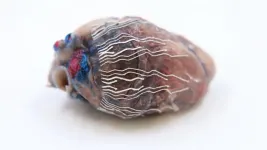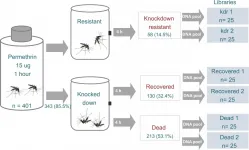(Press-News.org) SAN ANTONIO (June 17, 2021) -- Middle-aged people with depressive symptoms who carry a genetic variation called apolipoprotein (APOE) ε4 may be more at risk to develop tau protein accumulations in the brain's emotion- and memory-controlling regions, a new study by researchers from The University of Texas Health Science Center at San Antonio (UT Health San Antonio) and collaborating institutions suggests.
The Journal of Alzheimer's Disease published the findings in its June 2021 print issue. The research is based on depression assessments and positron emission tomography (PET) imaging conducted among 201 participants in the multigenerational Framingham Heart Study. The mean age of these participants was 53.
Decades before diagnosis
PET scans typically are conducted in older adults, so the Framingham PET studies in middle-aged persons are unique, said Mitzi M. Gonzales, PhD, lead author of the study and a neuropsychologist with the Glenn Biggs Institute for Alzheimer's and Neurodegenerative Diseases, which is part of UT Health San Antonio.
"This gives us an interesting opportunity to study people at midlife and get a sense of factors that might be associated with protein accumulations in individuals who are cognitively normal," Dr. Gonzales said. "These persons are likely decades before any type of dementia diagnosis, if they are to develop dementia in the future."
No associations found with amyloid beta
Amyloid beta (amyloid-β) and tau are proteins that aggregate in the brains of people with Alzheimer's disease and also typically increase to a milder extent with normal aging. The study found no associations of depressive symptoms and depression with amyloid-β. The only association was with tau, and only in APOE ε4 variant carriers. About one-fourth of the participants (47 of 201) were ε4 carriers, by virtue of having at least one copy of the ε4 allele.
Having one copy of APOE ε4 increases the risk of developing Alzheimer's by as much as two- to threefold, but some people with this variant live into their 80s and 90s and never develop the disease. "It's important to keep in mind that just because a person is identified as carrying the APOE ε4 allele does not mean that he will develop dementia in the future," Dr. Gonzales said. "It just means that the risk is higher."
Depressive symptoms (and depression if symptoms were severe enough to reach that diagnostic threshold) were evaluated with the Center for Epidemiological Studies Depression Scale at the time of PET imaging, as well as eight years prior. Associations between depressive symptoms and depression with PET outcomes at both time points were evaluated, adjusting for age and sex.
Centers of emotion and cognition
The study showed associations between depressive symptoms and increased tau in two brain regions, the entorhinal cortex and amygdala. "These associations do not infer that the tau accumulation causes the depressive symptoms, or vice versa," Dr. Gonzales said. "We only note that both are present in the ε4 carriers."
The entorhinal cortex is important for memory consolidation and tends to be an area where protein deposition occurs early on, she noted. The amygdala, meanwhile, is considered the emotion center of the brain.
"Longitudinal studies are needed to further understand what is happening, but it is intriguing to think about the clinical significance of our findings in terms of cognition as well as emotional regulation," Dr. Gonzales said.
INFORMATION:
Association of Midlife Depressive Symptoms with Regional Amyloid-β and Tau in the Framingham Heart Study
Mitzi M. Gonzales, Jasmeet Samra, Adrienne O'Donnell, R. Scott Mackin, Joel Salinas, Mini Jacob, Claudia L. Satizabal, Hugo J. Aparicio, Emma G. Thibault, Justin S. Sanchez, Rebecca Finney, Zoe B. Rubinstein, Danielle V. Mayblyum, Ron J. Killiany, Charlie S. Decarli, Keith A. Johnson, Alexa S. Beiser and Sudha Seshadri
First published: May 15, 2021 (online), Journal of Alzheimer's Disease
https://content.iospress.com/articles/journal-of-alzheimers-disease/jad210232
The University of Texas Health Science Center at San Antonio, also referred to as UT Health San Antonio, is one of the country's leading health sciences universities and is designated as a Hispanic-Serving Institution by the U.S. Department of Education. With missions of teaching, research, patient care and community engagement, its schools of medicine, nursing, dentistry, health professions and graduate biomedical sciences have graduated 39,700 alumni who are leading change, advancing their fields, and renewing hope for patients and their families throughout South Texas and the world. To learn about the many ways "We make lives better®," visit http://www.uthscsa.edu.
Stay connected with The University of Texas Health Science Center at San Antonio on Facebook, Twitter, LinkedIn, Instagram and YouTube.
To see how we are battling COVID-19, read inspiring stories on Impact.
LOS ALAMOS, N.M., June 17, 2021 -- A research team from Los Alamos National Laboratory and Purdue University have developed bio-inks for biosensors that could help localize critical regions in tissues and organs during surgical operations.
"The ink used in the biosensors is biocompatible and provides a user-friendly design with excellent workable time frames of more than one day," said Kwan-Soo Lee, of Los Alamos' Chemical Diagnostics and Engineering group.
The new biosensors allow for simultaneous recording and imaging of tissues and organs during surgical procedures.
"Simultaneous recording and imaging could be useful during heart surgery in localizing critical regions and guiding surgical interventions such as a procedure for restoring normal ...
Nanodecoys made from human lung spheroid cells (LSCs) can bind to and neutralize SARS-CoV-2, promoting viral clearance and reducing lung injury in a macaque model of COVID-19. By mimicking the receptor that the virus binds to rather than targeting the virus itself, nanodecoy therapy could remain effective against emerging variants of the virus.
SARS-CoV-2 enters a cell when its spike protein binds to the angiotensin-converting enzyme 2 (ACE2) receptor on the cell's surface. LSCs - a natural mixture of lung epithelial stem cells and mesenchymal cells - also express ACE2, making them a perfect vehicle ...
Current approaches for planning relocation for potentially millions of people affected by climate change and related risks are "woefully inadequate" and risk worsening societal inequities, experts wrote in a policy perspective on June 17 in Science. Policymakers and scientists need to rethink how they work together to develop, communicate and carry out relocation plans.
"Relocation involves moving people away from risk and into totally new settings," said the team of experts led by Richard Moss. Moss is a Gerhard R. Andlinger Visiting Fellow at Princeton's Andlinger Center ...
The Yellow fever mosquito (scientific name, Aedes aegypti) spreads multiple untreatable viruses in humans and is primarily controlled using a pesticide called permethrin. However, many mosquitoes are evolving resistance to the pesticide. A new study by Karla Saavedra-Rodriguez of Colorado State University and colleagues, published in the journal PLOS Genetics, identifies mutations linked to different permethrin resistance strategies, which threaten our ability to control disease outbreaks.
When treated mosquitoes encounter permethrin in the wild, they will do one of the following: immediately die, be knocked out but recover, or be unaffected. Saavedra-Rodriguez and her colleagues decided to investigate the genetic variations that lead to these ...
A new treatment approach focused on fixing cell damage, rather than fighting the virus directly, is effective against SARS-CoV-2 in lab models.
Combination of two drugs reduces spread of SARS-CoV-2 infection in cells by up to 99.5%.
If found safe for human use, this anti-viral treatment would make
COVID-19 symptoms milder and speed up recovery times.
When a person is infected with SARS-CoV-2, the virus that causes COVID-19, it invades their cells and uses them to replicate - which puts the cells under stress. Current approaches to dealing with infection target the virus itself with antiviral drugs. But ...
Patents with all-female inventor teams are more likely than all-male teams to address problems that specifically or disproportionately affect women, according to a new study. The findings, derived from an analysis of more than 440,000 U.S. biomedical patents filed from 1976 to 2010, suggest that who benefits most from innovation largely depends on who gets to invent. While the gender gap in research and innovation is well known, its broader impact on what gets invented - and for whom - isn't well understood. To address this question, Rembrand Koning and colleagues used machine learning text analysis to evaluate all U.S. biomedical patents filed from 1976 to 2010. They found that patents ...
Daunting and uncertain is the future for people who must decide whether, where, when, and how to vacate their homes as the climate changes. Communities who will absorb this influx of uprooted people also face challenges. In a special issue of Science, "Fallback Strategies: Planning for Climate-Induced Relocation," experts examine ways in which interdisciplinary basic and applied research can - and must - engage with and support communities and governments navigating this landscape. As this work is done, "we must consider not only what science can do, but how science ...
Using LIGO's suspended mirrors, researchers have demonstrated the ability to cool a large-scale object - the 10-kilogram optomechanical oscillator the suspended mirrors form - to nearly the motional quantum ground state. Upgrading LIGO (Laser Interferometer Gravitational-Wave Observatory) with such a modification would not only increase the device's sensitivity and range in detecting gravitational waves but could also provide new insights into large-scale quantum phenomena. For most mechanical objects to be coaxed into a quantum state, they need to be cooled to exceedingly low temperatures to overcome the thermal vibrations, or phonons, that mask the signature of quantum motion. This brings the ...
Marine-terminating glaciers may be less vulnerable to rapid and irreversible collapse than previously suggested, according to a new study, which finds that ice cliff collapse is limited by upstream thinning of the ice sheet and how quickly calved icebergs and sea-ice float away. The glaciers of Greenland and Antarctica slowly flow to the sea, terminating in massive vertical ice cliffs. Occasionally, these partially submerged margins can collapse under their own weight and trigger rapid disintegration of ice sheets. It's thought that this process, called marine ice cliff instability (MICI), could lead to the catastrophic retreat of some of the planet's largest ice sheets, substantially contributing to global sea level rise. However, current ...
CAMBRIDGE, MA -- To the human eye, most stationary objects appear to be just that -- still, and completely at rest. Yet if we were handed a quantum lens, allowing us to see objects at the scale of individual atoms, what was an apple sitting idly on our desk would appear as a teeming collection of vibrating particles, very much in motion.
In the last few decades, physicists have found ways to super-cool objects so that their atoms are at a near standstill, or in their "motional ground state." To date, physicists have wrestled small objects such as clouds of millions of atoms, or nanogram-scale objects, into such pure quantum states.
Now for the first time, scientists at MIT and elsewhere have cooled a large, human-scale object to close to its motional ground state. The object ...



